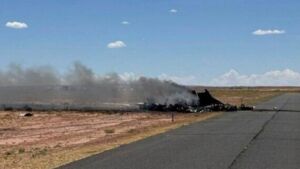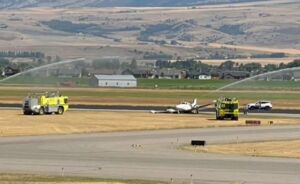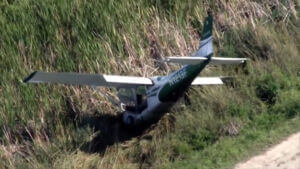These are your stories for today...
Be safe out there!
Tom
4 people die in crash of medical transport plane on Navajo Nation in northern Arizona
A small medical transport plane crashed and caught fire on the Navajo Nation in northern Arizona, killing four people
By JACQUES BILLEAUD Associated Press and LISA BAUMANN Associated Press
A small medical transport plane crashed and caught fire Tuesday on the Navajo Nation in northern Arizona, killing four people, the tribe said in a statement.
caught fire Tuesday on the Navajo Nation in northern Arizona, killing four people, the tribe said in a statement.
A Beechcraft King Air 300 from the CSI Aviation company left Albuquerque, New Mexico, with two pilots and two health care providers, according to the Federal Aviation Administration and CSI Aviation. It crashed in the early afternoon near the airport in Chinle, about 300 miles (483 kilometers) northeast of Phoenix.
“They were trying to land there and unfortunately something went wrong,” district Police Commander Emmett Yazzie said.
The crew was planning pick up a patient who needed critical care from the federal Indian Health Service hospital in Chinle, said Sharen Sandoval, director of the Navajo Department of Emergency Management. She said the plan was to return to Albuquerque. The patient's location and condition were not known Tuesday evening.
Tribal authorities began receiving reports at 12:44 p.m. of black smoke at the airport, Sandoval said. The cause of the crash wasn't known, the tribe said. The National Transportation Safety Board and the FAA are investigating.
CSI Aviation officials “with great sadness” confirmed the deaths in an emailed statement and extended condolences to the families, friends and loved ones of the people killed. Their names haven't been released.
The company is cooperating with the investigation, according to the statement.
Navajo Nation President Buu Nygren said in a social media post that he was heartbroken to learn of the crash.
“These were people who dedicated their lives to saving others, and their loss is felt deeply across the Navajo Nation,” he said.
Medical transports by air from the Navajo Nation are common because most hospitals are small and do not offer advanced or trauma care. The Chinle airport is one of a handful of airports that the tribe owns and operates on the vast 27,000 square-mile (70,000 square-kilometer) reservation that stretches into Arizona, New Mexico and Utah -- the largest land base of any Native American tribe.
In January, a medical transport plane crashed in Philadelphia, killing eight people. The National Transportation Safety Board, which is investigating the crash, has said the voice recorder on that plane was not working.
Associated Press journalists Hannah Schoenbaum in Salt Lake City and Felicia Fonseca in Flagstaff, Arizona, contributed to this report.
https://abcnews.go.com/US/wireStory/4-people-die-crash-medical-transport-plane-navajo-124396653
Small plane crashes at Bozeman Airport, no injuries reported
CEO Brian Sprenger says at least one flight was diverted.
By: Esha K. Walia
BOZEMAN — A Cessna 340, a small twin-engine propeller, crashed at Bozeman Yellowstone Airport around noon Tuesday afternoon, according to Brian Sprenger, chief executive officer for BZN. Sprenger confirmed to MTN that there were no injuries. He says at least one flight was diverted because of the crash.
propeller, crashed at Bozeman Yellowstone Airport around noon Tuesday afternoon, according to Brian Sprenger, chief executive officer for BZN. Sprenger confirmed to MTN that there were no injuries. He says at least one flight was diverted because of the crash.
The plane’s right landing gear collapsed on landing, he said, causing it to end up on the side of the runway. The airport used equipment to raise the aircraft off the ground and move it away from the runway, which Sprenger said was out of service for about an hour and scheduled to open just after 1:00 p.m.
https://www.kbzk.com/news/local-news/small-plane-crashes-at-bozeman-airport-no-injuries-reported
2 rescued after pilot makes emergency landing on Everglades levee; Pembroke Pines mayor urges county to take action
By Brandon Beyer, Alex Browning, Tynisa Senior, Nicole Linsalata, Kevin Boulandier
PEMBROKE PINES, FLA. (WSVN) - The mayor of the City of Pembroke Pines is urging Broward County to investigate the repeated crashes around North Perry Airport, hours after two people were rescued after their small plane had to make an emergency landing by the Florida Everglades.
On Tuesday, Broward Sheriff’s Office Fire Rescue units responded to reports of a plane that took a nose dive west of Everglades Holiday Park.
units responded to reports of a plane that took a nose dive west of Everglades Holiday Park.
FlightAware shows the plane took off from North Perry Airport in Pembroke Pines in the morning, but flew for about 20 minutes before circling twice and coming down.
Luckily, the two people on board walked away unharmed.
Audio recorded from inside the plane captured the panicked moment as the pilot looked for a good place to land.
“Mayday, Mayday, Mayday (unintelligible)… we are looking for the, uh, roads here,” said the pilot.
“There’s no airport near you but, it’s by the Everglades, can you, uh maybe find a dirt road?” said the tower operator.
“Yeah, I mean, I’m looking, I’m looking, I’m doing the best,” said the pilot.
Down below, Charter boat captain Bret Isackson watched it all play out, even snapping photos in the process.
“We were out fishing by the Miami canal and saw the plane start coming super low, but all you saw was it come down like it was landing but it came down nose first,” he said.
In the sky, a nearby pilot told tower operators what occurred.
“Looks like they just touched down on a dirt road, uh, we’ll keep an eye on them,” he said.
But the scene of downed planes have become an all too familiar scene for residents in the area near North Perry Airport.
Tuesday’s crash occurred about three weeks after another small plane crashed in a Pembroke Pines neighborhood, prompting nearby residents to help remove the family of four inside.
Records show four plane accidents in 2020 alone in the area.
The continued instances has prompted the city’s mayor, Angelo Castillo, to say enough is enough.
“We’ve had deaths, we’ve had serious injuries, we’ve had houses hit, enough is enough,” he said.
The City of Pembroke Pines has compiled a list of 42 incidents over five years from fatal crashes to mechanical mishaps.
7News has learned that on Wednesday, city commissioners will consider formally asking Broward County to look into the numbers and to take action.
“We are asking them to take safety seriously and stop making excuses,” said Castillo.
When asked by 7News if he wants North Perry Airport to close, Castillo said “I want safety at this airport.”
The mayor also pointed to the 2021 accident that killed 4-year-old Taylor Bishop, when a plane crashed into his mother’s car.
“We can’t have planes flying into trees, planes flying into cars, planes constantly ditching in the Everglades. Here in Pembroke Pines, we think it’s unsafe and they need to fix that,” said Castillo.
Federal investigators are looking into why this latest emergency landing in the Everglades took place.
During the Wednesday meeting, commissioners will also honor the neighbors who helped rescued the family of four in Pembroke Pines.
https://wsvn.com/news/local/broward/2-rescued-after-pilot-makes-emergency-landing-on-everglades-levee-pembroke-pines-mayor-urges-county-to-take-action/
NTSB Prelim: Kolb Firestar
A Family Member Reported That The Pilot Departed His Private Airstrip About 1610
Location: Meadow Grove, NE Accident Number: CEN25FA261
Date & Time: July 19, 2025, 20:50 Local Registration: N55161
Aircraft: Kolb Firestar Injuries: 1 Fatal
Flight Conducted Under: Part 91: General aviation - Personal
On July 19, 2025, about 2050 central daylight time, a Kolb Firestar airplane, N55161, was destroyed when it was involved in an accident near Meadow Grove, Nebraska. The pilot was fatally injured. The airplane was operated as a Title 14 Code of Federal Regulations Part 91 personal flight.
A family member reported that the pilot departed his private airstrip about 1610. Local authorities were notified of the accident about 2050 when a property owner noticed the airplane in his soybean field. There were no witnesses, and the exact time of the accident is unknown.
The accident site was located in a soybean field about 0.3 mile south of the departure airstrip. Initial ground impact was about 50 ft from the wreckage, and the impact path was oriented on a southwest heading. The forward portion of the fuselage was crushed aft, and the cockpit area was compromised. The left wing was separated at the root and retained by the wing strut.
The right wing remained attached to the fuselage at the root with the wing strut intact. The tailboom was fractured about 2 ft aft of the fuselage consistent with impact forces. It was retained by the elevator and rudder cables. The empennage remained attached to the tail boom. The upper portion of the vertical stabilizer and rudder were deformed consistent with the impact sequence.
Aileron control continuity was continuous from the control stick to the wing roots, and from the wing roots to the ailerons. Aileron control rod end separations at the wing roots appeared consistent with overstress failures resulting from the impact. The torque tube from the control stick to the aft fuselage was deformed consistent with the impact damage. Both ailerons remained attached to the wings at the hinges. Control cable continuity from the control stick to the elevators and from the rudder pedals to the rudder horn was confirmed.
At the time of the on-scene examination, the engine was separated and rested adjacent to the fuselage. The engine assembly appeared intact. Both intake air filters and carburetors were separated. The left carburetor was located in the debris path. The right carburetor was retained by the fuel inlet hose. Internal engine and gearbox continuity were confirmed via rotation of the crankshaft. Two propeller blades remained attached to the hub and appeared intact. One propeller blade was separated at the root and located in the debris path. The separated blade was deformed and delaminated consistent with ground impact.
The engine ignition modules and engine monitor were retained for further evaluation.
FMI: www.ntsb.gov

Today in History
20 Years ago today: On 6 August 2005 Tuninter flight 1153, an ATR 72-202, crashed into the sea after a los of engine power due to fuel exhaustion, killing 16 occupants; 23 survived the accident.
| Date: | Saturday 6 August 2005 |
| Time: | 15:40 |
| Type: | ATR 72-202 |
| Owner/operator: | Tuninter |
| Registration: | TS-LBB |
| MSN: | 258 |
| Year of manufacture: | 1991 |
| Total airframe hrs: | 29893 hours |
| Cycles: | 35259 flights |
| Engine model: | P&W Canada PW124B |
| Fatalities: | Fatalities: 16 / Occupants: 39 |
| Other fatalities: | 0 |
| Aircraft damage: | Destroyed, written off |
| Category: | Accident |
| Location: | 26 km NE off Palermo-Punta Raisi Airport (PMO) - Italy |
| Phase: | En route |
| Nature: | Passenger - Non-Scheduled/charter/Air Taxi |
| Departure airport: | Bari Karol Wojtyla Airport (BRI/LIBD) |
| Destination airport: | Djerba-Melita Airport (DJE/DTTJ) |
| Investigating agency: | ANSV |
| Confidence Rating: | Accident investigation report completed and information captured |
Narrative:
Tuninter flight 1153, an ATR 72-202, crashed into the sea after a los of engine power due to fuel exhaustion, killing 16 occupants; 23 survived the accident.
On August 5, 2005 Tuninter's ATR-72 TS-LBB arrived at Tunis Airport with 790 kg of fuel left in the fuel tanks. During maintenance the Fuel Quantity Indicator (FQI) was changed. Erroneously the FQI for ATR-42 aircraft was installed. The normal operation of the FQI is to processes the signal coming from the capacitance probes installed in the tanks with an algorithm typical for each aircraft, depending on tank shape, size and number of probes installed. The indication of the amount of fuel on board the airplane now read 3050 kg instead of 790 kg.
On August 6 the airplane was prepared for flight 152F to Bari. An amount of 465 kg fuel was added for the flight (total fuel: 1255 kg, with 3800 kg indicated). Upon landing at Bari only 305 kg were left in the tanks. Normally this should have triggered a 'LO LVL' warning, but the FQI read 2300 kg, which made the crew believe they had plenty of fuel left. In preparation for the flight to Djerba, just 265 kg of fuel was added. The flight departed with 2700 kg of fuel indicated by the FQI (actual amount: 570 kg).
En route, at 15:24 the crew contacted Palermo for an emergency landing. They had run out of fuel and both engines had quit. Their FQI nevertheless showed 1800 kg of fuel. They did not make it to Palermo and ditched in the sea around 15:40.
CAUSE AND CONTRIBUTING FACTORS:
The accident under examination, as most aviation accidents, has been determined by a series of events linked one another, which caused the final ditching. The ditching was primarly due to the both engines flame out because of fuel exhaustion.
The incorrect replacement of the fuel quantity indicator (FQI) was one of the contributing factors which led irremediably to the accident.
The accident's cause is therefore traceable firstly to the incorrect procedure used for replacing the FQI, by means of the operator's maintenance personnel. This shall be considered the disruptive element, which caused the final ditching of the aircraft due to the lack of fuel that caused the shutdown of both engines.
As said before the accident was determined by a series of events (contributing factors) linked one another. Hereafter are listed some considered of major importance.
- Errors committed by ground mechanics when searching for and correctly identifying the fuel indicator.
- Errors committed by the flight crew: non-respect of various operational procedures.
- Inadequate checks by the competent office of the operator that flight crew were respecting operational procedures.
- Inaccuracy of the information entered in the aircraft management and spares information system and the absence of an effective control of the system itself.
- Inadequate training for aircraft management and spares information system use and absence of a responsible person appointed for managing the system itself.
- Maintenance and organization standards of the operator unsatisfactory for an adequate aircraft management.
- Lack of an adequate quality assurance system;
- Inadequate surveillance of the operator by the competent Tunisian authority.
- Installation characteristics of fuel quantity indicators (FQI) for ATR 42 and ATR 72 which made it possible to install an ATR 42 type FQI in an ATR 72, and viceversa.
The analysis of various factors that contributed to the event has been carried out according to the so called Reasons "Organizational accident" model. Active failures, which had triggered the accident, are those committed both by ground mechanics/technicians the day before the event while searching for and replacing the fuel quantity indicator, and by the crew who did not verify and fully and accurately complete the aircrafts documentation, through which it would have been possible to perceive an anomalous situation regarding the quantity of fuel onboard.
Latent failures, however, remained concealed, latent in the operator's organizational system until, some active errors (by mechanics and pilots) were made, overcoming the system's defence barriers, causing the accident.
Analysing latent and active failures (errors) traceable to various parties, involved in the event in several respects, it clearly emerges that they were operating in a potentially deceptive organizational system. When latent failures remain within a system without being identified and eliminated, the possibility of mutual interaction increases, making the system susceptible for active failures, or not allowing the system to prevent them, in case of errors. Active failures were inserted in a context characterised by organizational and maintenance deficiencies.
The error that led to the accident was committed by mechanics who searched for and replaced the FQI, but this error occurred in an organizational setting in which, if everybody were operating correctly, probably the accident would not have occurred.
Inaccuracy of information entered in the aircraft management and spares information system, particularly regarding the interchangeability of items and the absence of an effective control of the system itself, has been considered in fact one of the latent failures that contributed to the event. The maintenance and organization standards of the operator, at the time of event, were not considered satisfactory for an adequate management of the aircraft.
